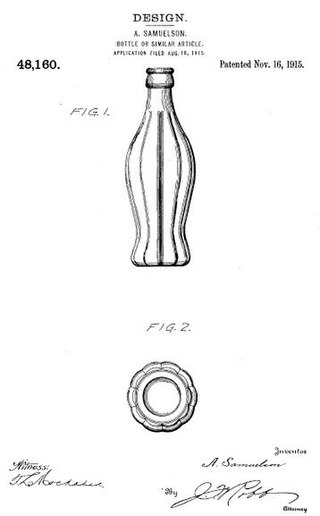
Type design is the art and process of designing typefaces. This involves drawing each letterform using a consistent style. The basic concepts and design variables are described below.

A typeface is a design of letters, numbers and other symbols, to be used in printing or for electronic display. Most typefaces include variations in size, weight, slope, width, and so on. Each of these variations of the typeface is a font.

Arial is a sans-serif typeface and set of computer fonts in the neo-grotesque style. Fonts from the Arial family are included with all versions of Microsoft Windows after Windows 3.1, as well as in other Microsoft programs, Apple's macOS, and many PostScript 3 printers.

An industrial design right is an intellectual property right that protects the visual design of objects that are purely utilitarian. An industrial design consists of the creation of a shape, configuration or composition of pattern or color, or combination of pattern and color in three-dimensional form containing aesthetic value. An industrial design can be a two- or three-dimensional pattern used to produce a product, industrial commodity or handicraft.

Courier is a monospaced slab serif typeface. Courier was created by IBM in the mid-1950s, and was designed by Howard "Bud" Kettler (1919–1999). The Courier name and typeface concept are in the public domain. Courier has been adapted for use as a computer font, and versions of it are installed on most desktop computers.

Industrial property is one of two subsets of intellectual property, it takes a range of forms, including patents for inventions, industrial designs, trademarks, service marks, layout-designs of integrated circuits, commercial names and designations, geographical indications and protection against unfair competition. In some cases, aspects of an intellectual creation, although present, are less clearly defined. The object of industrial property consists of signs conveying information, in particular to consumers, regarding products and services offered on the market. Protection is directed against unauthorized use of such signs that could mislead consumers, and against misleading practices in general.
Intellectual property rights (IPRs) have been acknowledged and protected in China since 1980. China has acceded to the major international conventions on protection of rights to intellectual property. Domestically, protection of intellectual property law has also been established by government legislation, administrative regulations, and decrees in the areas of trademark, copyright, and patent.

In the United States, a design patent is a form of legal protection granted to the ornamental design of an article of manufacture. Design patents are a type of industrial design right. Ornamental designs of jewelry, furniture, beverage containers and computer icons are examples of objects that are covered by design patents.

The Copyright, Designs and Patents Act 1988, also known as the CDPA, is an Act of the Parliament of the United Kingdom that received royal assent on 15 November 1988. It reformulates almost completely the statutory basis of copyright law in the United Kingdom, which had, until then, been governed by the Copyright Act 1956 (c. 74). It also creates an unregistered design right, and contains a number of modifications to the law of the United Kingdom on Registered Designs and patents.
The Design Piracy Prohibition Act, H.R. 2033, S. 1957, and H.R. 2196, were bills of the same name introduced in the United States Congress that would have amended Title 17 of the United States Code to provide sui generis protection to fashion designs for a period of three years. The Acts would have extended protection to "the appearance as a whole of an article of apparel, including its ornamentation," with "apparel" defined to include "men's, women's, or children's clothing, including undergarments, outerwear, gloves, footwear, and headgear;" "handbags, purses, and tote bags;" belts, and eyeglass frames. In order to receive the three-year term of protection, the designer would be required to register with the U.S. Copyright Office within three months of going public with the design.

The following outline is provided as an overview of and topical guide to intellectual property:

A trademark is a type of intellectual property consisting of a recognizable sign, design, or expression that identifies a product or service from a particular source and distinguishes it from others. A trademark owner can be an individual, business organization, or any legal entity. A trademark may be located on a package, a label, a voucher, or on the product itself. Trademarks used to identify services are sometimes called service marks.

Iran is a member of the WIPO since 2001 and has acceded to several WIPO intellectual property treaties. Iran joined the Convention for the Protection of Industrial Property in 1959. In December 2003 Iran became a party to the Madrid Agreement and the Madrid Protocol for the International Registration of Marks. In 2005 Iran joined the Lisbon Agreement for the Protection of Appellations of Origin and their International Registration, which ensures the protection of geographical names associated with products. As at February 2008 Iran had yet to accede to The Hague Agreement for the Protection of Industrial Designs.

Utopia is the name of a transitional serif typeface designed by Robert Slimbach and released by Adobe Systems in 1989.

Adobe Systems, Inc. v. Southern Software, Inc. was a case in the United States District Court for the Northern District of California regarding the copyrightability of digitized typefaces. The case is notable since typeface designs in general are not protected under United States copyright law, as determined in Eltra Corp. v. Ringer. Since that case, the United States Copyright Office has published policy decisions acknowledging the registration of computer programs that generate typefaces. In this case, the court held that Adobe's Utopia font was protectable under copyright and Southern Software, Inc.'s Veracity font was substantially similar and infringing.
Japanese design law is determined by the Design Act. Under this Act, only registered designs are legally protected, and it stipulates the procedure for obtaining a design registration in the Japan Patent Office. The protection for unregistered design is provided by the Unfair Competition Prevention Act. The Act amended in 2019 to expand its scope of protections of graphic images and interior and exterior designs of the architectures, to extend the protection term to 25 years from the filing date, and to accept multiple designs filings.

Peter Karow is a German entrepreneur, inventor and software developer. He holds several patents in the field of desktop publishing and is known for his work on computer fonts. He contributed with several books and patents to the development of operating systems for computers. He is recognized as the inventor of outline computer fonts.
The protection of intellectual property (IP) of video games through copyright, patents, and trademarks, shares similar issues with the copyrightability of software as a relatively new area of IP law. The video game industry itself is built on the nature of reusing game concepts from prior games to create new gameplay styles but bounded by illegally direct cloning of existing games, and has made defining intellectual property protections difficult since it is not a fixed medium.
Fashion design copyright refers to the web of domestic and international laws that protect unique clothing or apparel designs. The roots of fashion design copyright may be traced in Europe to as early as the 15th century.
Intellectual property of Ethiopia is managed by the Ethiopian Intellectual Property Office (EIFO), who oversees Intellectual Property Right (IPR) issues. Ethiopia has not signed IPR treaty such as the Paris Convention for the Protection of Industrial Property, the World Intellectual Property Organization (WIPO) copyright treaty, the Berne Convention for Literary and Artistic Works, the Madrid System for the International Registration of Marks, and the Patent Cooperation Treaty.











